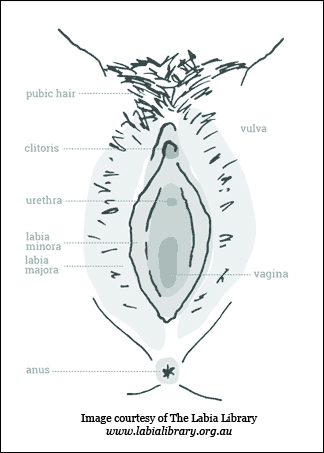Your labia are the skin folds that are external to the vaginal opening. Some women refer to these as the ‘lips’ or ‘flaps’. There are two parts of the labia, the labia majora (the outer folds of skin) and the labia minora (the inner, thinner folds). Their main role is in protection of the vagina as well as providing sensation and lubrication for sexual intercourse.
So what is normal for the labia? Well, there is a very wide variation actually! Each as unique as their owner.
“Innie or an outie?”
The labia minora are longer than the labia majora in about 50% of women. Some women feel self-conscious about this appearance, but it is normal and every second woman has the same.
“But one side is longer than the other…”
Asymmetrical labia are also very common and again, very normal. Nature rarely gets two sides of the body exactly the same, which is why we often have one foot or breast which is slightly larger than the other, or ears which are not quite at the same height.

“I’m worried about the colour…”
Labia come in many colours too, ranging from light to dark pink, or brown with tinges of purple and blue that can be more prominent in pregnancy. If you develop areas of the labia which lose all colour and turn white, or if you notice discrete coloured lumps or moles, it is a good idea to get your gynaecologist to check that everything is normal. Sometimes a small biopsy is required to help diagnose dermatological conditions of the labia and vulva.
“Do I need surgery or labiaplasty?”
Surgical treatment of the labia minora is rarely necessary, but has become more common over the past decade, with the term ‘designer vagina’ one that is often mentioned in the media. See your gynaecologist if you think there is a problem with your labia. Remember that because the labia have a very good nerve supply, it is possible that surgery could cause ongoing issues with pain, either day to day or with intercourse.
“Is labia scrutiny a new phenomenon?”
A few factors have probably contributed to increased scrutiny of this area. Vulval hair removal is now very common and now more and more women are removing all of their pubic hair. The result of this is obviously that the labia are more visible, but also that they can more easily be irritated as they do not have the hair causing a layer of cushioning between the labia and clothing.
Coupled with this are fashion trends towards increasingly tight clothing which can place too much pressure on the labia causing discomfort.
Finally, pornography is much more accessible, and at younger ages than previously. This may contribute to pressure placed on women by themselves, their partner, or friends about the perception of normal. Unfortunately pornography does not represent normal in the same way that pictures of models do not represent normal women. Photo-shopping of labia is a real thing! If someone has said something to you about your labia they most probably don’t have a good idea themselves of the variation of normal.
So – what is our advice?
Love your labia! They are serving an important purpose and they are unique to you!
Try to ignore unhelpful comments about your body – this goes for all body parts, not just your labia. If someone is trying to put you down, consider whether you want that person in your life. If you think they just don’t understand, then educate them. The Labia Library (yes, this is a real website!) is a great resource for looking at all of the variations of normal.
Lastly, if you have labial irritation consider how you might be able to help. This might include changing your routine for personal hygiene or hair growth, decreasing the tightness of your clothing and of course seeing your gynaecologist if there are any lesions or areas of concern.